
With Valentine’s Day around the corner, single Americans have a range of hopes when it comes to their romantic lives. Some dream of serious relationships, some are looking for casual dates and some are avoiding dating altogether. Here are five findings about single Americans, based on a Pew Research Center survey of U.S. adults conducted July 5-17, 2022.
Pew Research Center conducted this study to better understand single Americans, from their romantic goals to their experiences with online dating. This survey was conducted among 6,034 U.S. adults from July 5-17, 2022. This included 4,996 respondents from the Center’s American Trends Panel (ATP), an online survey panel that is recruited through national, random sampling of residential addresses. This way nearly all U.S. adults have a chance of selection. It also included an oversample of 1,038 respondents from Ipsos’ KnowledgePanel who indicated that they are lesbian, gay or bisexual (LGB), with oversampled groups weighted back to reflect proportions in the population. The survey is weighted to be representative of the U.S. adult population by gender, race, ethnicity, partisan affiliation, education and other categories. Read more about the ATP’s methodology.
Here are the questions used for this analysis, along with responses, and its methodology.
Lesbian, gay and bisexual (LGB) adults are combined because of small sample sizes. Additionally, since this research is focused on sexual orientation, not gender identity, and due to the fact that the transgender population in the U.S. is very small, transgender respondents are not identified separately. Read the full online dating report for more details.
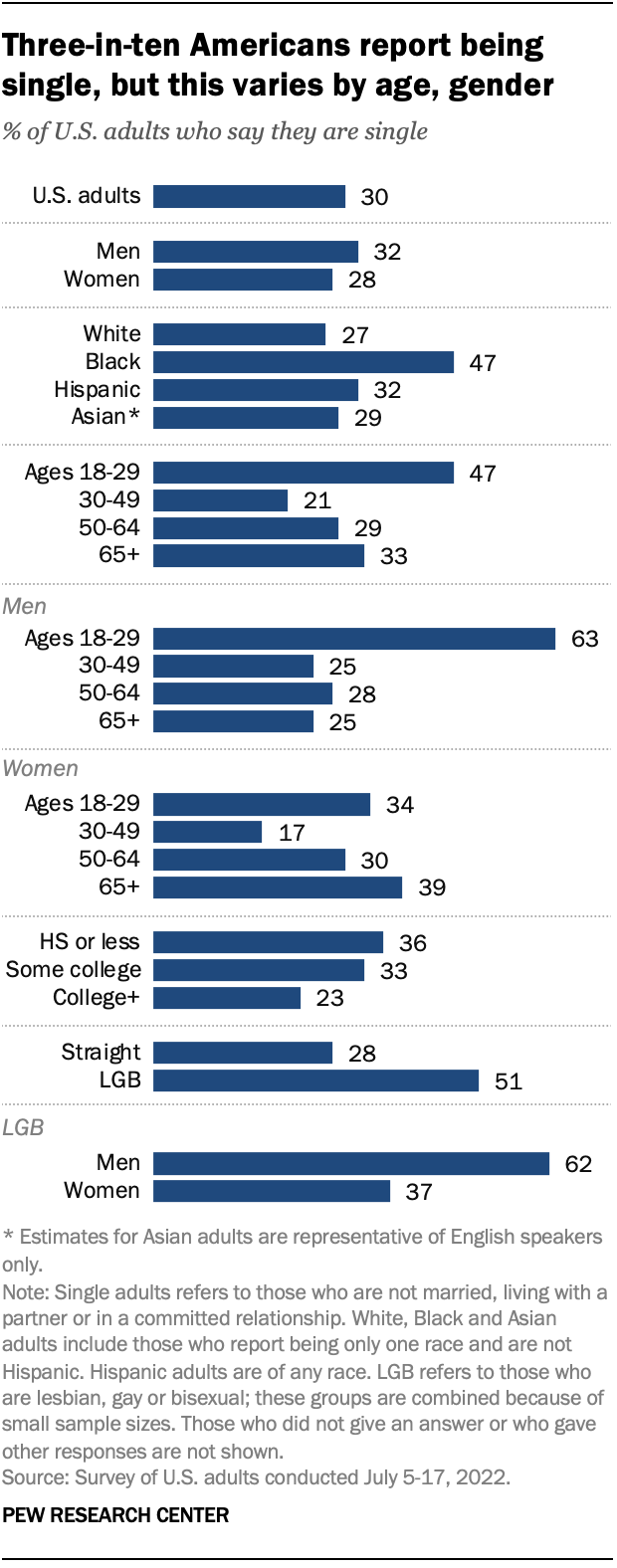
Roughly six-in-ten young men report being single. Overall, three-in-ten U.S. adults are single, meaning they are not married, living with a partner or in a committed romantic relationship. This share has not changed since the Center asked this question in 2019.
Some age groups have a higher share of singles than others. Adults under 30 are the most likely age group to be single, with roughly half (47%) falling into this category. In contrast, 30- to 49-year-olds are the least likely to be single (21%). About three-in-ten adults ages 50 to 64 or 65 and older say they are single.
When looking at age and gender together, 63% of men under 30 describe themselves as single, compared with 34% of women in the same age group. Younger men are also far more likely than older men to be single – a pattern that is not as straightforward among women. Women ages 18 to 29, for example, are just as likely as women 65 and older to report being single.
The proportion of unpartnered adults also varies by race and ethnicity, educational attainment and sexual orientation. For instance, 47% of Black adults report being single, higher than the share among other racial and ethnic groups.
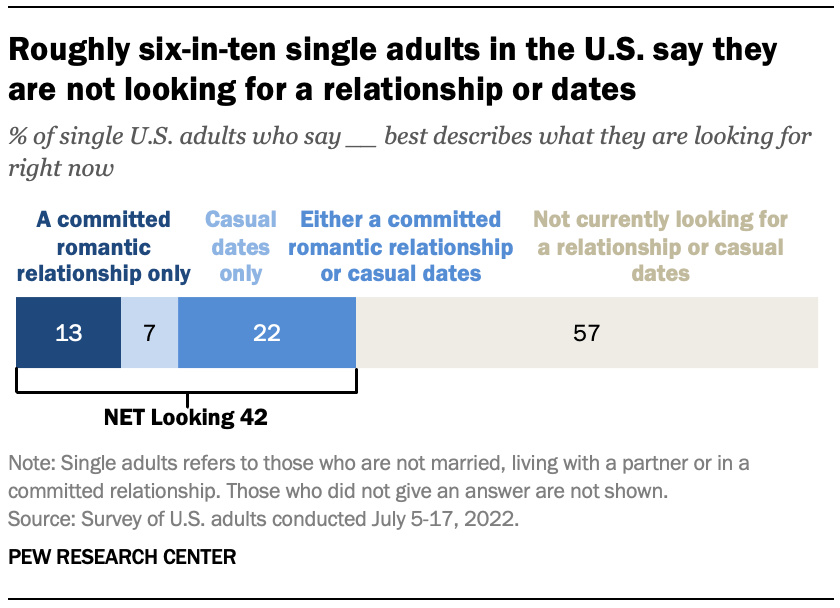
The majority of single adults are not interested in being struck (or even grazed) by Cupid’s arrow. Among Americans who are single, the largest share – 57% – say they are not currently looking for a relationship or casual dates. (In a February 2022 Center survey, single adults who were not looking for a relationship or dates identified a variety of reasons as to why, but enjoying being single and having other priorities topped the list.)
Even among adults who are “single and looking,” not everyone is interested in the same type of relationship. Roughly one-in-five single adults (22%) say they are open to either a committed relationship or casual dates, while 13% say they are only looking for a committed relationship and 7% are only looking for casual dates. In total, 42% of single Americans are looking for some kind of romance.
Single men are more likely than their female counterparts to be searching for romantic experiences. Half of these men are looking for a committed relationship and/or casual dates, while 35% of single women say the same.
Younger singles are also more likely than older singles to say they are currently looking for dates and/or a relationship. Some 57% of unpartnered adults under 50 say this, compared with 36% of those 50 to 64 and 16% of those 65 and older.
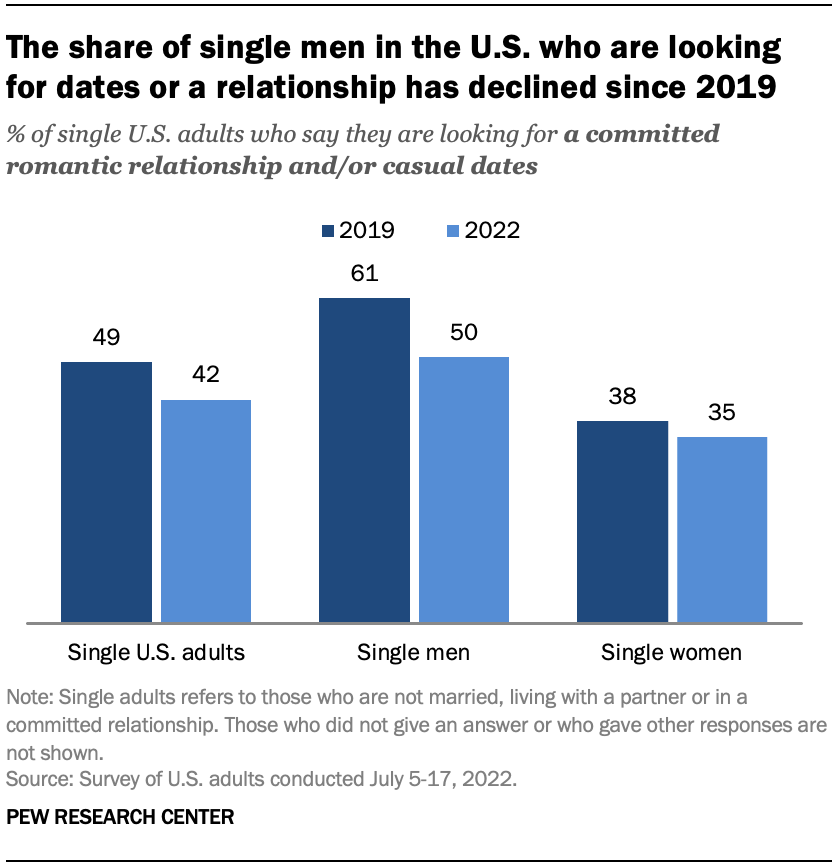
The percentage of single Americans who are looking for a relationship or casual dates is lower than in 2019, especially among men. Some 42% of single Americans say they’re looking for a committed romantic relationship and/or casual dates, down from 49% in 2019 (but similar to the proportion found in the Center’s February 2022 survey).
This drop is largely driven by single men, who are now 11 percentage points less likely than in 2019 to say they are looking for a committed relationship and/or casual dates (50% in July 2022, down from 61% in 2019). During the same time frame, there has been no significant change in the share of single women who are looking for a relationship or casual dates: 35% said this in 2022, compared with 38% in 2019.
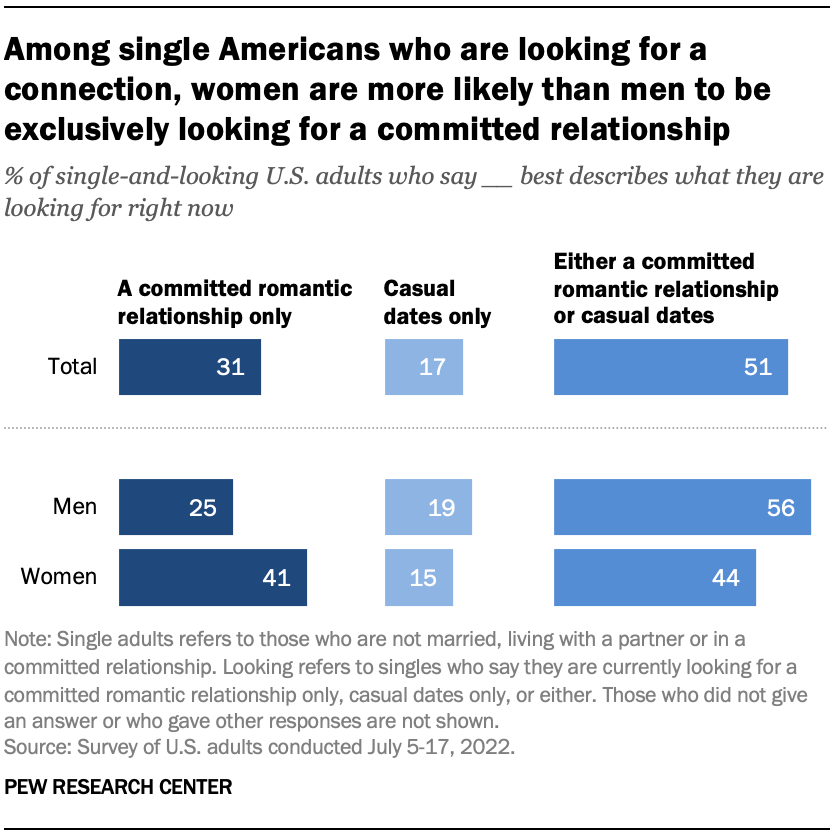
The type of relationship single Americans are looking for varies by gender. Among singles who are on the dating market, about half (51%) say they are open to either a committed relationship or casual dates. Looking at those who are only open to one of these options, daters are more likely to be exclusively looking for a committed relationship over casual dates only (31% vs. 17%).
But this varies by gender: 56% of men who are looking for romance say they’re open to either a committed relationship or casual dates, while only 44% of single-and-looking women say the same. Single-and-looking women, in turn, are more likely than their male counterparts to say they are only looking for a committed romantic relationship (41% vs. 25%).
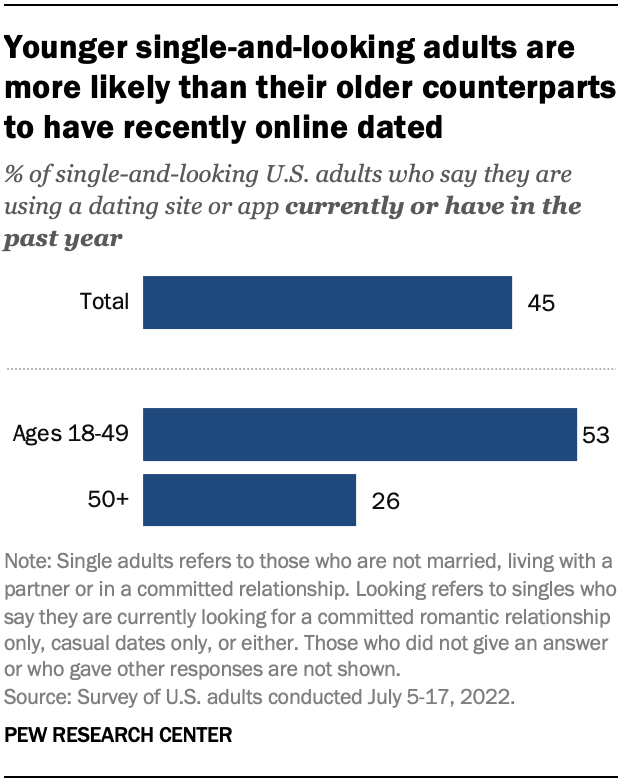
Nearly half of single-and-looking adults have turned to online dating in the past year. Some 45% of single Americans who are searching for a relationship and/or casual dates have used an online dating platform within the past year, including those who were on one currently as of the July 2022 survey.
Younger single-and-looking adults are more likely than their older counterparts to have used a dating site or app in this time period. Roughly half (53%) of adults under 50 who are single and looking have used an online dating platform recently, compared with about a quarter (26%) of single-and-looking adults 50 and older.
Note: Here are the questions used for this analysis, along with responses, and its methodology.




